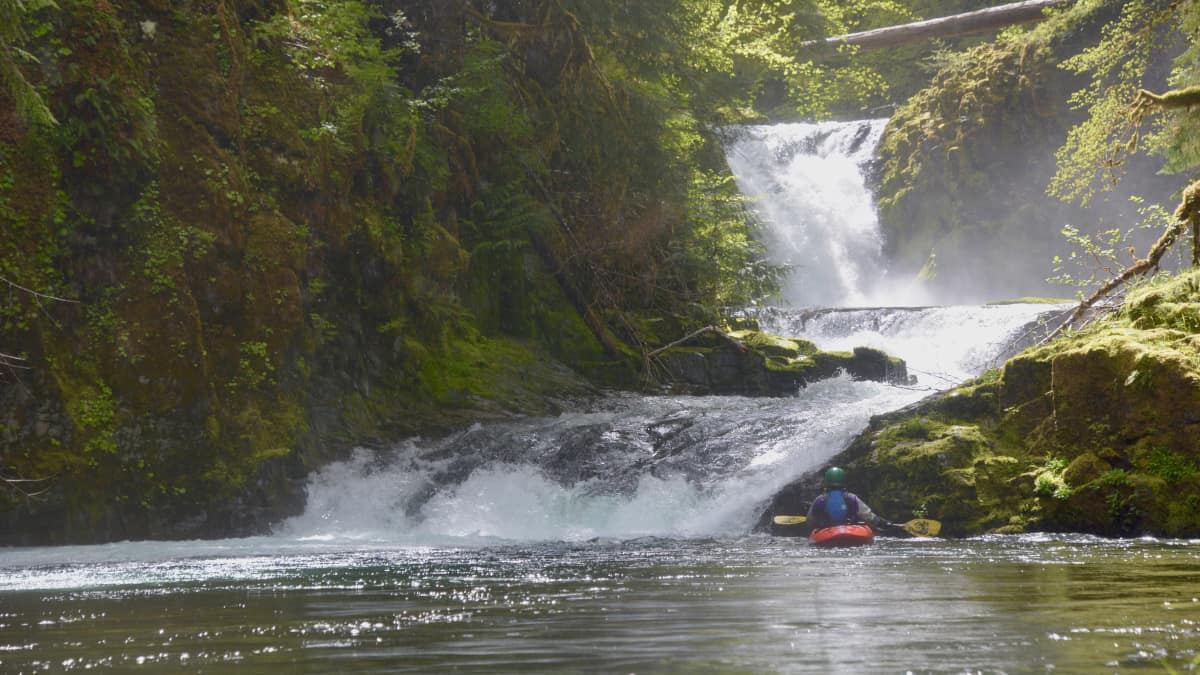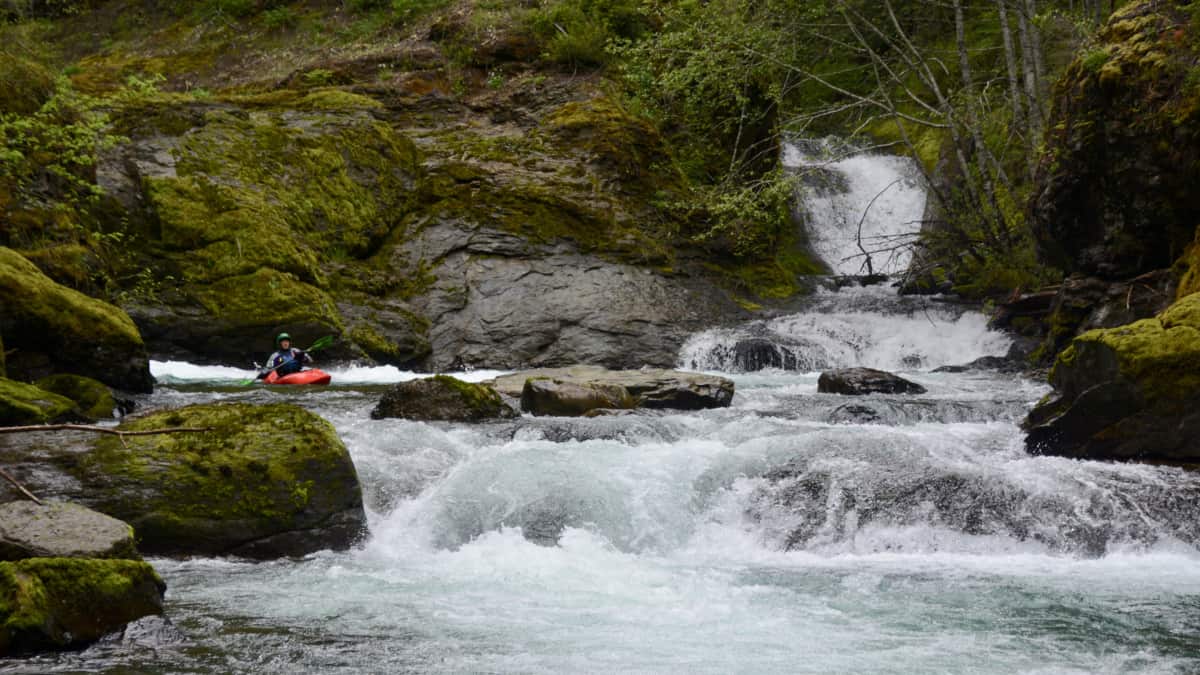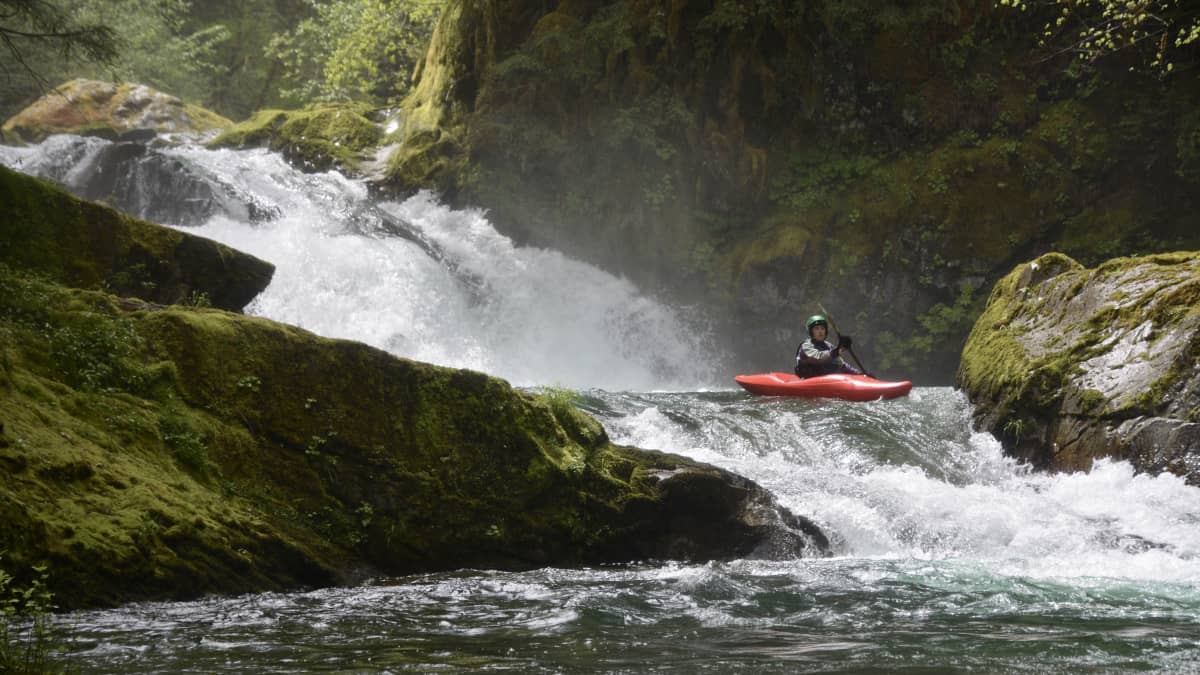Yellowjacket Creek is a remote and beautiful run in the Cispus drainage in Southwest Washington. This run offers a little bit of everything with boulder gardens, ledges, slides, a few waterfalls and a memorable portage all packed into a beautiful canyon.
*Note on sections: Historically the run was accessed via a steep hike to avoid a big waterfall located in the upper canyon. While some groups will still opt to access this lower or “guidebook” section of Yellowjacket, it is becoming increasingly common to use a roadside put-in upstream to avoid the steep hike in and add some additional drops and a memorable throw-and-go portage (for most). Given this upper section would never be run without also paddling the lower, this entry refers to Yellowjacket as one run. That said, the traditional Yellowjacket access offers a worthy adventure with stunning scenery that is a half grade easier than the upper and doesn’t require a 40+ foot jump.
The first few bends offer some easy warm up that will be a little scrapy at low to medium flows.
Trip Highlights
Mile 0.85: Approach each corner with caution as the First Falls (V, Portage) has a tendency to sneak up on paddlers. An unremarkable class II lead-in constricts and bends to the right before dropping over a 10ft ledge that lands amongst rocks. Catch an eddy early on river right to portage.
After the portage the river enter an enjoyable bedrock section with a handful of class III-IV
Rapids that are boat scoutable.
Mile 1.7: A twisting entry leads to a small, swift pool before dropping over a 15 foot slide to autoboof (IV+) best run on the right side of the flake. This drop deposits you in a beautiful walled-in pool and is quite possibly the highlight of the run. While the drop itself is straightforward, the limited time to recover after the class IV lead-in increases the difficulty and consequence of the drop. There is one more ledge to contend with at the exit of the pool before the river eases off until the big falls.
Mile 2.35: The Big Falls (V, Portage) is another drop that should be approached with caution given a slowly building boulder garden leads right into the lip with no last chance eddies. That being this said, this falls should be easy enough to identify by the downstream horizon line framed by a log spanning the river. Eddy out on the left to scout or begin the process of portaging. The left side of this 30+ foot falls lands on a rock but the falls has seen successful descents at higher flows. Most will opt to throw their boats and jump from a perch that is about 40 feet above water level. While the pool below is large, it is helpful for one person to go first and get in their boat at the bottom to help collect the boats and jumpers that follow. (It is possible to portage this falls without the jump but it would take much longer and still has some steep exposure to return to river level).

Looking back upstream at Big Falls and the exit ledges. The throw-and-go portage ledge is visible to the right of Big Falls.
Mile 2.4: Just downstream of the falls the action continues with the Exit Ledges (IV/IV+). This series begins with a fun slide into a hole that can be punched in the center followed by a smaller ledge 4-5 foot ledge that can be run center left. (Just below these drops is where the run begins for those using the traditional access via the steep bushwack described in the Bennet guidebook.)
Mile 2.6: A fun boulder garden (III+/IV-) rapid lies just downstream and it frequently collects wood but is easily scoutable on river right.
Mile 2.8: The Meteorite (III+) is a series of shallow slides that can be run center to right.
Mile 3.0: McCoy Creek enters on the right adding to the flow shortly before Godzilla (IV). This series of three ledges increase in retentiveness with the third drop best run on the right.
Mile 3.6: A large midstream rock in a class III signals the approach to 7-Foot Falls (IV). A pool above the falls and rock bench extending from river right permits a scout at low to medium flows. While much of the river slams into a pillow against the river left wall, it can easily be skirted by running this steep slide on the far right shoulder. At high flows, a line opens up on river right.
After the falls the river continues through enjoyable III-III+ boulder gardens that are all easily boat scouted.
Mile 5.2: An impressive wall rising out of the water on the right signals the final rapid of note (III+/IV-). Here a boulder garden funnels down into a constriction against the wall. Wood would be bad here but it is easy to scout from river left.
After a few more bends, the canyon opens up and the run finishes with half a mile of woody shallows before reaching the FR 28 bridge.








